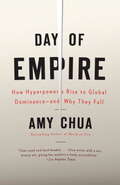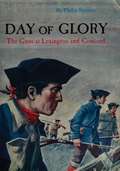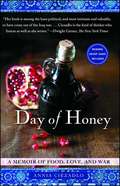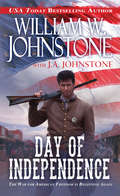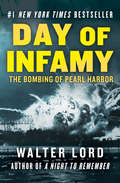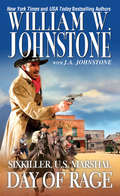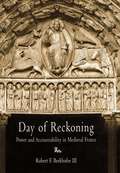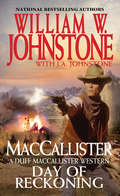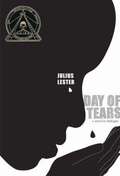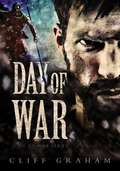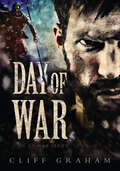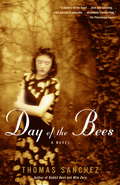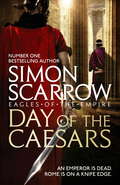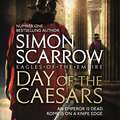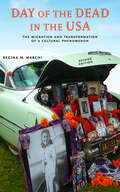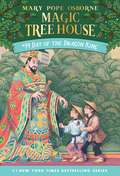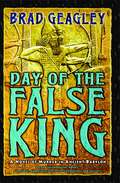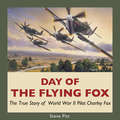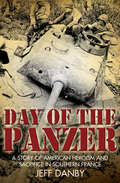- Table View
- List View
Day of Empire
by Amy ChuaIn this sweeping history, bestselling author Amy Chua explains how globally dominant empires--or hyperpowers--rise and why they fall. In a series of brilliant chapter-length studies, she examines the most powerful cultures in history--from the ancient empires of Persia and China to the recent global empires of England and the United States--and reveals the reasons behind their success, as well as the roots of their ultimate demise.Chua's analysis uncovers a fascinating historical pattern: while policies of tolerance and assimilation toward conquered peoples are essential for an empire to succeed, the multicultural society that results introduces new tensions and instabilities, threatening to pull the empire apart from within. What this means for the United States' uncertain future is the subject of Chua's provocative and surprising conclusion.From the Trade Paperback edition.
Day of Empire: How Hyperpowers Rise to Global Dominance--and Why They Fall
by Amy ChuaIn a little over two centuries, America has grown from a regional power to a superpower, and to what is today called a hyperpower. But can America retain its position as the world's dominant power, or has it already begun to decline? Historians have debated the rise and fall of empires for centuries. To date, however, no one has studied the far rarer phenomenon of hyperpowers--those few societies that amassed such extraordinary military and economic might that they essentially dominated the world. Now, in this sweeping history of globally dominant empires, bestselling author Amy Chua explains how hyperpowers rise and why they fall. In a series of brilliantly focused chapters, Chua examines history's hyperpowers--Persia, Rome, Tang China, the Mongols, the Dutch, the British, and the United States--and reveals the reasons behind their success, as well as the roots of their ultimate demise. Chua's unprecedented study reveals a fascinating historical pattern. For all their differences, she argues, every one of these world-dominant powers was, at least by the standards of its time, extraordinarily pluralistic and tolerant. Each one succeeded by harnessing the skills and energies of individuals from very different backgrounds, and by attracting and exploiting highly talented groups that were excluded in other societies. Thus Rome allowed Africans, Spaniards, and Gauls alike to rise to the highest echelons of power, while the "barbarian" Mongols conquered their vast domains only because they practiced an ethnic and religious tolerance unheard of in their time. In contrast, Nazi Germany and imperial Japan, while wielding great power, failed to attain global dominance as a direct result of their racial and religious intolerance. But Chua also uncovers a great historical irony: in virtually every instance, multicultural tolerance eventually sowed the seeds of decline, and diversity became a liability, triggering conflict, hatred, and violence. The United States is the quintessential example of a power that rose to global dominance through tolerance and diversity. The secret to America's success has always been its unsurpassed ability to attract enterprising immigrants. Today, however, concerns about outsourcing and uncontrolled illegal immigration are producing a backlash against our tradition of cultural openness. Has America finally reached a "tipping point"? Have we gone too far in the direction of diversity and tolerance to maintain cohesion and unity? Will we be overtaken by rising powers like China, the EU or even India? Chua shows why American power may have already exceeded its limits and why it may be in our interest to retreat from our go-it-alone approach and promote a new multilateralism in both domestic and foreign affairs.
Day of Glory
by Philip SpencerIt is April 19, 1775.7:00 p.m.: The boy Solomon Brown hurries down the road to Lexington, carrying secret papers to Sam Adams and John Hancock. Ahead loom nine British officers--armed!Midnight: Paul Revere gallops by moonlight to warn every household that the British are coming.4:00 a.m.: The colonists march solemnly behind the drummer out onto the Lexington green.Hour by hour, you relive the day the American Revolution began. It is a Day of Blood and a Day of Glory--and YOU ARE THERE!
Day of Honey
by Annia CiezadloA luminous portrait of life in the Middle East, Day of Honey weaves history, cuisine, and firsthand reporting into a fearless, intimate exploration of everyday survival. In the fall of 2003, Annia Ciezadlo spent her honeymoon in Baghdad. Over the next six years, while living in Baghdad and Beirut, she broke bread with Shiites and Sunnis, warlords and refugees, matriarchs and mullahs. Day of Honey is her memoir of the hunger for food and friendship--a communion that feeds the soul as much as the body in times of war. Reporting from occupied Baghdad, Ciezadlo longs for normal married life. She finds it in Beirut, her husband's hometown, a city slowly recovering from years of civil war. But just as the young couple settles into a new home, the bloodshed they escaped in Iraq spreads to Lebanon and reawakens the terrible specter of sectarian violence. In lucid, fiercely intelligent prose, Ciezadlo uses food and the rituals of eating to illuminate a vibrant Middle East that most Americans never see. We get to know people like Roaa, a determined young Kurdish woman who dreams of exploring the world, only to see her life under occupation become confined to the kitchen; Abu Rifaat, a Baghdad book lover who spends his days eavesdropping in the ancient city's legendary cafés; Salama al-Khafaji, a soft-spoken dentist who eludes assassins to become Iraq's most popular female politician; and Umm Hassane, Ciezadlo's sardonic Lebanese mother-in-law, who teaches her to cook rare family recipes--which are included in a mouthwatering appendix of Middle Eastern comfort food. As bombs destroy her new family's ancestral home and militias invade her Beirut neighborhood, Ciezadlo illuminates the human cost of war with an extraordinary ability to anchor the rhythms of daily life in a larger political and historical context. From forbidden Baghdad book clubs to the oldest recipes in the world, Ciezadlo takes us inside the Middle East at a historic moment when hope and fear collide. Day of Honey is a brave and compassionate portrait of civilian life during wartime--a moving testament to the power of love and generosity to transcend the misery of war.
Day of Honey: A Memoir of Food, Love, and War
by Annia CiezadloA luminous portrait of life in the Middle East, Day of Honey weaves history, cuisine, and firsthand reporting into a fearless, intimate exploration of everyday survival. In the fall of 2003, Annia Ciezadlo spent her honeymoon in Baghdad. Over the next six years, while living in Baghdad and Beirut, she broke bread with Shiites and Sunnis, warlords and refugees, matriarchs and mullahs. Day of Honey is her memoir of the hunger for food and friendship--a communion that feeds the soul as much as the body in times of war. Reporting from occupied Baghdad, Ciezadlo longs for normal married life. She finds it in Beirut, her husband's hometown, a city slowly recovering from years of civil war. But just as the young couple settles into a new home, the bloodshed they escaped in Iraq spreads to Lebanon and reawakens the terrible specter of sectarian violence. In lucid, fiercely intelligent prose, Ciezadlo uses food and the rituals of eating to illuminate a vibrant Middle East that most Americans never see. We get to know people like Roaa, a determined young Kurdish woman who dreams of exploring the world, only to see her life under occupation become confined to the kitchen; Abu Rifaat, a Baghdad book lover who spends his days eavesdropping in the ancient city's legendary cafés; Salama al-Khafaji, a soft-spoken dentist who eludes assassins to become Iraq's most popular female politician; and Umm Hassane, Ciezadlo's sardonic Lebanese mother-in-law, who teaches her to cook rare family recipes--which are included in a mouthwatering appendix of Middle Eastern comfort food. As bombs destroy her new family's ancestral home and militias invade her Beirut neighborhood, Ciezadlo illuminates the human cost of war with an extraordinary ability to anchor the rhythms of daily life in a larger political and historical context. From forbidden Baghdad book clubs to the oldest recipes in the world, Ciezadlo takes us inside the Middle East at a historic moment when hope and fear collide. Day of Honey is a brave and compassionate portrait of civilian life during wartime--a moving testament to the power of love and generosity to transcend the misery of war.
Day of Independence
by William W. Johnstone J.A. JohnstoneA Texas frontier town is ready to fight for its independence from a ruthless cattle baron in this Western by the authors of Savage Texas.One hundred years ago, American patriots picked up rifles and fought against British tyranny. That was in Boston, where the enemy was King George III and his British troops. Now, in Last Chance, Texas, in the Big Bend River country, the enemy is Abraham Hacker, a ruthless cattle baron who will slaughter anyone who tries to lay claim to the fertile land—or anything on it. For Last Chance, freedom is under siege one violent act at a time. Then wounded Texas Ranger Hank Cannan arrives in town. When he sees the terrorized townsfolk, Cannan is ready to start a second revolution. It's going to take a lot of guts. But Cannan is ready to set Last Chance free with bullets, blood, and a willingness to die—or kill—for freedom.
Day of Infamy: The Bombing of Pearl Harbor (Military History Ser.)
by Walter LordThe #1 New York Times–bestselling account: &“There have been many books on Pearl Harbor . . . but none of them have equaled Lord&’s&” (Stephen E. Ambrose). The Day of Infamy began as a quiet morning on the American naval base at Pearl Harbor. But as Japan&’s deadly torpedoes suddenly rained down on the Pacific fleet, soldiers, generals, and civilians alike felt shock, then fear, then rage. From the chaos, a thousand personal stories of courage emerged. Drawn from hundreds of interviews, letters, and diaries, Walter Lord recounts the many tales of heroism and tragedy by those who experienced the attack firsthand. From the musicians of the USS Nevada who insisted on finishing &“The Star Spangled Banner&” before taking cover, to the men trapped in the capsized USS Oklahoma who methodically voted on the best means of escape, each story conveys the terror and confusion of the bombing raid, as well as the fortitude of those who survived.
Day of Rage (Sixkiller, U.S. Marshal #2)
by William W. Johnstone J.A. JohnstoneUSA Today bestselling author: One man stands between a murderous gang and a fortune in gold bullion . . .Into a lawless town rode a hero named John Henry Sixkiller . . . Only William W. Johnstone with J. A. Johnstone could tell a tale of violence and vengeance so real, so raw, it outdoes the legends of Old West justice that inspired it.On the American frontier, history is written by bulletsIt was there for the taking: $75,000 in gold bullion, the combined payrolls of three productive gold mines, just waiting to be stolen from under the noses of a bickering sheriff and city marshal. Billy Ray Gilmore and his band of kill-crazy outlaws have a plan to do it, too—that is, until Sixkiller comes to town. Hiding his badge to conceal his identity as a US marshal, Sixkiller goes undercover to smoke out the culprits before they strike. But in this town full of two-legged rattlesnakes, deadly surprises lurk behind every saloon door. To keep from being bitten, Sixkiller will have to lay a few traps of his own. Lucky for him, what this town lacks in law, it makes up for in guns—and dynamite.
Day of Reckoning
by Robert F. Berkhofer IIIDay of Reckoning: Power and Accountability in Medieval France applies recent approaches to literacy, legal studies, memory, ritual, and the manorial economy to reexamine the transformation of medieval power. Highlighting the relationship of archives and power, it draws on the rich documentary sources of five of the largest Benedictine monasteries in northern France and Flanders, with comparisons to others, over a period of nearly four centuries. The book opens up new perspectives on important problems of power, in particular the idea and practice of accountability. In a violent society, medieval lords tried to delegate power rather than share it--to get their men to prosecute justice or raise money legitimately, rather than through extortion and pillage. Robert F. Berkhofer III explains how subordinates were held accountable by abbots administering the extensive holdings of Saint-Bertin, Saint-Denis, Saint-Germain-des-Prés, Saint-Père-de-Chartres, and Saint-Vaast-d'Arras. As the abbots began to discipline their agents and monitor their conduct, the "day of reckoning" took on new meaning, as customary meeting days were used to hold agents accountable. By 1200, written and unwritten techniques of rule developed in the monasteries had moved into the secular world; in these practices lay the origins of administration, bureaucratic power, and governance, all hallmarks of the modern state.
Day of Reckoning (A Duff MacCallister Western #7)
by William W. Johnstone J. A. JohnstoneTHE GREATEST WESTERN WRITERS OF THE 21ST CENTURY The legendary MacCallister clan brought 500 years of Highlander tradition, honor, and fighting courage to the American frontier. In an astounding new novel from the national bestselling Johnstones, Duff MacCallister rides into the Colorado mountains with a young girl at his side—and a gang of stone-cold killers eagerly waiting for them . . . DAY OF RECKONING When Duff MacCallister sees smoke rising from his neighbor’s ranch, he knows that something is very wrong. But he isn’t prepared for what he finds: smoldering buildings, a rancher and his wife brutally slaughtered, and a 14-year-old survivor who could not save her parents. Now, Duff is going after the killers—and his only companion is the headstrong girl who refuses to be left behind. Duff and his new companion head into the towering Gore Range. Up ahead are two convicted murderers who were about to be hung in Cheyenne, and the killers who broke them lose. Duff doesn’t have a plan—or a prayer. But the girl will be more help than he can know, and when the day of reckoning comes, bullets and blood will prove who is the bravest and fiercest fighter of all . . .
Day of Reckoning: A Novel
by Ralph De ToledanoFirst published in 1955, Day of Reckoning by Ralph de Toledano, author of Seeds of Treason, is a novel based on the 1943 assassination of Carlo Tresca, an Italian-American newspaper editor, orator, and labor organizer who was a leader of the Industrial Workers of the World during the 1910s.The murder of an idealistic anarchist prompts an inquiry by Paul Castelar, an honest newspaperman and a veteran of the International Brigade in the Spanish Civil War.He is drawn in by Gina Farrel, the murdered man’s niece, who comes to him convinced that the same political gangster who killed her uncle is now after her…A gripping read!
Day of Tears
by Julius LesterOn March 2 and 3, 1859, the largest auction of slaves in American history took place in Savannah, Georgia. More than 400 slaves were sold. On the first day of the auction, the skies darkened and torrential rain began falling. The rain continued throughout the two days, stopping only when the auction had ended. The simultaneity of the rain storm with the auction led to these two days being called "the weeping time." Master storyteller Julius Lester has taken this footnote of history and created the crowning achievement of his literary career. Julius Lester tells the story of several characters including Emma, a slave owned by Pierce Butler and caretaker of his two daughters, and Pierce, a man with a mounting gambling debt and household to protect. Emma wants to teach his daughters--one who opposes slavery and one who supports it--to have kind hearts. Meanwhile, in a desperate bid to survive, Pierce decides to cash in his "assets" and host the largest slave auction in American history. And on that day, the skies open up and weep endlessly on the proceedings below. Using the multiple voices of enslaved Africans and their owners, Julius Lester has taken a little-known, all-true event in American history and transformed it into a heartbreaking and powerfully dramatic epic on slavery, and the struggle to affirm humanity in the midst of it.<P><P>Winner of the Coretta Scott King Medal
Day of War (Lion of War #1)
by Cliff GrahamDay of War, author Cliff Graham's first novel, has earned him a film option for the entire book series---Lion of War---from director David L. Cunningham (Path to 9/11) and producer Grant Curtis (Spider-Man films). In ancient Israel, at the crossroads of the great trading routes, a man named Benaiah is searching for a fresh start in life. He has joined a band of soldiers led by a warlord named David, seeking to bury the past that refuses to leave him. Their ragged army is disgruntled and full of reckless men. Some are loyal to David, but others are only with him for the promise of captured wealth. While the ruthless and increasingly mad King Saul marches hopelessly against the powerful Philistines, loyal son Jonathan in tow, the land of the Hebrew tribes has never been more despondent---and more in need of rescue. Over the course of ten days, from snowy mountain passes to sword-wracked battlefields, Benaiah and his fellow mercenaries must call upon every skill they have to survive and establish the throne for David---if they don't kill each other first.
Day of War: Day Of War, Covenant Of War (Lion of War Series #1)
by Cliff GrahamIn ancient Israel, at the crossroads of the great trading routes, a man named Benaiah is searching for a fresh start in life. He has joined a band of soldiers led by a warlord named David, seeking to bury the past that refuses to leave him. Their ragged army is disgruntled and full of reckless men. Some are loyal to David, but others are only with him for the promise of captured wealth. While the ruthless and increasingly mad King Saul marches hopelessly against the powerful Philistines, loyal son Jonathan in tow, the land of the Hebrew tribes has never been more despondent—and more in need of rescue. Over the course of ten days, from snowy mountain passes to sword-wracked battlefields, Benaiah and his fellow mercenaries must call upon every skill they have to survive and establish the throne for David—if they don&’t kill each other first. Day of War brings to life the exploits of the Mighty Men of Israel, a rag-tag band of disgruntled warriors on the run with David, the soon-to-be King. Their legendary deeds are recorded in 2 Samuel 23 and 1 Chronicles 11
Day of the Bees
by Thomas SanchezIn this story of an astonishing love, Thomas Sanchez portrays the violence, hope, and grandeur of lives transformed by war and exile. At the heart of the novel are Zermano, a world-famous Spanish painter, and his beautiful French muse, Louise Collard -- whose lives are torn apart by the German invasion of France in World War II. Leaving Louise in Vichy-controlled Provence, Zermano returns to occupied Paris. But while he eventually goes on to celebrity and fortune, Louise disappears into obscurity.Fifty years later, after Louise's death, an American scholar arrives in the south of France seeking the truth about the lovers' tempestuous romance and sudden separation. Why did the painter abandon the young beauty? What was the cause of her lifelong reclusiveness? What dark mysteries were being concealed by the ill-fated couple? By chance, the professor finds a cache of correspondence -- Zermano's letters to Louise in her remote mountain village, and her intentionally unmailed letters to him in Paris. In their vivid, wrenching contents he uncovers secrets that Louise kept even from Zermano about her wartime experience: the dangers of her participation in the Resistance, and her complicity with one of its leaders, the Fly; her struggles to elude a sadistic officer who hunts her for political and personal reasons; her lyrical intimacy with a mystical beekeeper. Louise is forced to make a fateful decision between the love for her man, and the ultimate sacrifice for her country.In a powerful climax, the scholar is compelled to journey to Mallorca, where Zermano is rumored to be living in self-imposed exile. Determined to reveal Louise's fate to the painter, our narrator does not suspect that he, too, will be forced to confront the enigma of his own desire.From the Hardcover edition.
Day of the Blizzard
by Stephen Gammell Marietta D. MoskinA brave little girl named Katie goes through a lot of trouble to get her mama's brooch back from the pawn shop.
Day of the Caesars (Eagles of the Empire #16)
by Simon ScarrowThe Sunday Times bestsellerAD 54. Claudius is dead. Rome is in turmoil. And two brave heroes of the Roman army face the challenge of their lives. Simon Scarrow's DAY OF THE CAESARS is not to be missed by readers of Conn Iggulden and Bernard Cornwell. 'A new book in Simon Scarrow's series about the Roman army is always a joy' The TimesThe Emperor Claudius is dead. Nero rules. His half-brother Britannicus has also laid claim to the throne. A bloody power struggle is underway. All Prefect Cato and Centurion Macro want is a simple army life, fighting with their brave and loyal men. But Cato has caught the eye of rival factions determined to get him on their side. To survive, Cato must play a cunning game, and enlist the help of the one man in the Empire he can trust: Macro.As the rebel force grows, legionaries and Praetorian Guards are moved like chess pieces by powerful and shadowy figures. A political game has created the ultimate military challenge. Can civil war be averted? The future of the Empire is in Cato's hands...IF YOU DON'T KNOW SIMON SCARROW, YOU DON'T KNOW ROME!
Day of the Caesars (Eagles of the Empire 16)
by Simon ScarrowThe Sunday Times bestsellerAD 54. Claudius is dead. Rome is in turmoil. And two brave heroes of the Roman army face the challenge of their lives. Simon Scarrow's DAY OF THE CAESARS is not to be missed by readers of Conn Iggulden and Bernard Cornwell. 'A new book in Simon Scarrow's series about the Roman army is always a joy' The TimesThe Emperor Claudius is dead. Nero rules. His half-brother Britannicus has also laid claim to the throne. A bloody power struggle is underway. All Prefect Cato and Centurion Macro want is a simple army life, fighting with their brave and loyal men. But Cato has caught the eye of rival factions determined to get him on their side. To survive, Cato must play a cunning game, and enlist the help of the one man in the Empire he can trust: Macro.As the rebel force grows, legionaries and Praetorian Guards are moved like chess pieces by powerful and shadowy figures. A political game has created the ultimate military challenge. Can civil war be averted? The future of the Empire is in Cato's hands...IF YOU DON'T KNOW SIMON SCARROW, YOU DON'T KNOW ROME!
Day of the Caesars (Eagles of the Empire 16)
by Simon ScarrowAD 55. Claudius is dead. Rome is in turmoil. And two brave heroes of the Roman army face the challenge of their lives. Simon Scarrow's DAY OF THE CAESARS is not to be missed by readers of Conn Iggulden and Bernard Cornwell. 'A new book in Simon Scarrow's series about the Roman army is always a joy' The TimesThe Emperor Claudius is dead. Nero rules. His half-brother Britannicus has also laid claim to the throne. A bloody power struggle is underway. All Prefect Cato and Centurion Macro want is a simple army life, fighting with their brave and loyal men. But Cato has caught the eye of rival factions determined to get him on their side. To survive, Cato must play a cunning game, and enlist the help of the one man in the Empire he can trust: Macro.As the rebel force grows, legionaries and Praetorian Guards are moved like chess pieces by powerful and shadowy figures. A political game has created the ultimate military challenge. Can civil war be averted? The future of the empire is in Cato's hands...IF YOU DON'T KNOW SIMON SCARROW, YOU DON'T KNOW ROME!(P)2017 Headline Publishing Group Ltd.
Day of the Dead in the USA, Second Edition: The Migration and Transformation of a Cultural Phenomenon (Latinidad: Transnational Cultures in the United States)
by Regina M MarchiHonoring relatives by tending graves, building altars, and cooking festive meals has been a major tradition among Latin Americans for centuries. The tribute, "El Día de los Muertos," has enjoyed renewed popularity since the 1970s when Latinx activists and artists in the United States began expanding "Day of the Dead" north of the border with celebrations of performance art, Aztec danza, art exhibits, and other public expressions. Focusing on the power of public ritual to serve as a communication medium, this revised and updated edition combines a mix of ethnography, historical research, oral history, and critical cultural analysis to explore the manifold and unexpected transformations that occur when the tradition is embraced by the mainstream. A testament to the complex role of media and commercial forces in constructions of ethnic identity, Day of the Dead in the USA provides insight into the power of art and ritual to create community, transmit oppositional messages, and advance educational, political, and economic goals. Today Chicano-style Day of the Dead events take place in all fifty states. This revised edition provides new information about: The increase in events across the US, incorporating media coverage and financial aspects, Recent political movements expressed in contemporary Day of the Dead celebrations, including #BlackLivesMatter and #MeToo Greater media coverage and online presence of the celebration in blogs, websites, and streaming video Día de los Muertos themes and iconography in video games and films The proliferation of commercialized merchandise such as home goods, apparel, face paints and jewelry at mainstream big box and web retailers, as well as the widespread proliferation of calavera-themed decorations and costumes for Halloween 24 new full color illustrations
Day of the Dragon King
by Mary Pope Osborne Sal MurdoccaThe #1 bestselling chapter book series of all time celebrates 25 years with new covers and a new, easy-to-use numbering system! Who would burn books? Jack and Annie find out when the Magic Tree House whisks them back to ancient China. There, a powerful emperor called the Dragon King has ordered that all books be burned. Will Jack and Annie be able to save at least one book? Or will they be captured by the emperor's soldiers? Did you know that there’s a Magic Tree House book for every kid? Magic Tree House: Adventures with Jack and Annie, perfect for readers who are just beginning chapter books Merlin Missions: More challenging adventures for the experienced reader Super Edition: A longer and more dangerous adventure Fact Trackers: Nonfiction companions to your favorite Magic Tree House adventures Have more fun with Jack and Annie at MagicTreeHouse.com!
Day of the Dragon King (Magic Tree House #14)
by Mary Pope Osborne Sal MurdoccaWho would burn books?Jack and Annie find out when the Magic Tree House whisks them back to ancient China. There, a powerful emperor called the Dragon King has ordered that all books be burned. Will Jack and Annie be able to save at least one book? Or will they be captured by the emperor's soldiers?
Day of the False King
by Brad GeagleyAnother brilliant and out-of-the-ordinary murder mystery by the author of Year of the Hyenas, with an unusual and interesting detective, this time trying to pursue and rescue his own ex-wife, sold into slavery in the city of Babylon (in modern times, near Baghdad) at a time of violence and great danger, much like today. Day of the False King continues the story of Semerket, Egypt's Clerk of Investigations and Secrets. The time is approximately 1150 B.C., and the conspirators who plotted the overthrow of Pharaoh Ramses III have been tried and executed. But the old pharaoh has succumbed to the wounds inflicted by his Theban wife, Queen Tiya; it is his first-born son who now rules Egypt as his chosen successor, Ramses IV. Geographically placed at the center of the Old World, where East literally meets West, Babylon has forever been the crossroads for conquering armies and adventuresome merchants, and the prize of dynasts. From cruel tyrants to far-seeing visionaries, an ever-changing set of rulers have claimed Babylon's throne as their own. But they were not god-kings as in Egypt; in fact, there was no term for "king" in any of the Babylonian languages. Instead, they were called simply "Strong Man" or "Big Man." Then as now, only martial strength determined who ruled. Strangely, or perhaps inevitably, the rights of the individual were first codified and set down as laws here. Around the time that Day of the False King takes place, the Middle East is undergoing -- just as it is today -- a tortuous, protracted transformation. The old regimes have vanished, setting the stage for the aggressive emergence of the new nations of Phoenicia, Israel, and Philistia; it is the fourth of these new peoples, the Assyrians, who will achieve dominance in the years ahead. Babylonia in particular has suffered a series of cataclysms. The old Kassite Dynasty, themselves invaders from the north, has been toppled. The nation of Elam (soon to be known as Persia) has launched a massive war to conquer Babylonia from the southeast. Native tribes in the country also see this moment as their own chance to evict the foreigners and re-establish a dynasty of their own. Into this roiling alchemy, Semerket's adored ex-wife, Naia, is thrust. She and Rami, the tomb-maker's son, have been banished to Babylon as indentured servants -- punishment for their accidental roles in the Harem Conspiracy against Ramses III. As in Year of the Hyenas, most of the events and characters in Day of the False King are drawn from history. The Elamite invader King Kutir and the native-born Marduk truly vied for the throne of Babylonia. There really was a festival called Day of the False King, when the entire world turned upside down for a day, when slaves ruled as masters, when the most foolish man in Babylon was chosen to become king. Semerket the detective is plunged into the midst of these events in pursuit of his own goals: to serve his Pharaoh and to find the woman he loves.
Day of the Flying Fox: The True Story of World War II Pilot Charley Fox
by Steve PittCommended for the 2009 Best Books for Kids & Teens Canadian World War II pilot Charley Fox, now in his late eighties, has had a thrilling life, especially on the day in July 1944 in France when he spotted a black staff car, the kind usually employed to drive high-ranking Third Reich dignitaries. Already noted for his skill in dive-bombing and strafing the enemy, Fox went in to attack the automobile. As it turned out, the car contained famed German General Erwin Rommel, the Desert Fox, and Charley succeeded in wounding him. Rommel, who at the time was the Germans’ supreme military commander in France orchestrating the Nazis’ resistance to the D-day invasion, was never the same after that. Author Steve Pitt focuses on this seminal event in Charley Fox’s life and in the war, but he also provides fascinating aspects of the period, including profiles of noted ace pilots Buzz Beurling and Billy Bishop, Jr., and Great Escape architect Walter Floody, as well as sidebars about Hurricanes, Spitfires, and Messerschmitts.
Day of the Panzer: A Story of American Heroism and Sacrifice in Southern France
by Jeff Danby“[An] excellent popular history . . . a sprightly and evocative tribute to the troops of Operation Dragoon” (Publishers Weekly).This is a rarely detailed, “you are there” account of World War II combat, describing a brief but bloody tank/infantry action in August 1944. Based on six years of research—drawing from interviews, primary documents, and visits to the battlefield—The Day of the Panzer transports the reader into the ranks of L Company, 15th Regiment, Third Infantry Division, and its supporting M4s of the 756th Tank Battalion as they grapple head-on with the Wehrmacht.On August 15, 1944, L Company hit the beaches in southern France, joined by the tank crews of 2nd Lt. Andrew Orient’s 3rd Platoon, all veterans of Cassino. Despite logistical problems, the Third Division forged north through the Rhône River valley, L Company and its supporting tanks leading the regimental charge—until they faced a savage counterattack by the Germans and a rampaging Panther tank . . .In this book, the minute-by-minute confusion, thrill, and desperation of WWII combat is placed under a microscope, as if the readers themselves were participants. “Through his well-wrought prose, Danby paints a detailed picture of deadly fighting and stunning victory” (WWII History).“One of the most interesting and absorbing battles histories that this reviewer has ever read . . . remarkably realistic and personal.” —History Book Club“The excellent descriptions of infantrymen, tankers and supporting troops from the 15th’s Cannon Company using M8 self-propelled howitzers and the three inch gun armed M10s of the 601st Tank Destroyer Battalion make for good reading.” —War History Online
